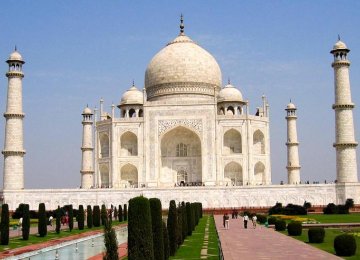A sunny noon this April 6, tourism entrepreneur Arvind Bhardwaj was simultaneously grappling with both riches and ruin at Byasi town, in the Himalayan state of Uttarakhand, northern India. He became ingredient in the curiously cooking case of a $4.2 billion industry being both economy maker and breaker, writes Raja Murthy in an article in Asia Times Online.
Bhardwaj was inspecting a new restaurant site his adventure sports company ‘Red Chilli’ had leased for a year, to complement their booming Ganges riverside camping site 30 kms beyond Rishikesh.
The growth discussion was, however, clouded with worries of a court or government order to shut down approximately fifty companies running beach camps by the Ganges. A non-governmental organization (NGO) had earlier filed litigation accusing the local government of polluting the Ganges. Too many riverside campers, cried the NGO in court.
Two hours later, over a late lunch of rice and cottage cheese curry at his Red Chilli camp site, Bhardwaj was mulling over hope-horror prospects with manager Nansraj Thapa. Business was booming, yet it could go bust.
“Thousands of people’s livelihoods are involved,” said Thapa, unimpressed with extinction prospects for the riverside camping tribe. “There will be riots if the government shuts down the Ganges river camps.”
Thousands more depend on income from river-rafting and trekking business. A thriving tourism industry and related infrastructure is changing lives in remote Himalayan hamlets – at least at the economic level.
En route to Kuari Pass, for instance, close to the India-China border and about 250 km from Rishikesh, I found young villagers earning five-figure monthly salaries, watching satellite TV and using cell phones. They were shepherds five years ago, before getting well-paid jobs as security guards and laborers for a major hydroelectric dam project in the area.
Unsustainable Development
With more tourist inflow, which provides more jobs for locals, Uttarakhand needs more electricity, more tourism infrastructure. But this boom has pushed the sensitive Himalayan-Gangetic ecosystem into unanticipated catastrophes, like the flash floods of 2013 that killed over 5,000 people.
Barely a year earlier, in August 2012, major power grids crashed in the region due to electricity demand exceeding supply. Over 600 million people were affected in northern and eastern India.
The tourism industry took two years to stagger back to its feet. But I am not sure if locals have learnt lessons from the calamity, or have even invested time to examine what led to it. Those forgetting history, as the wise old jungle book says, are condemned to repeat it.
Earlier this April, I saw another cycle of tourism boom in Rishikesh – with attendant shadows of another environment-related bust. On Saturday and Sunday nights of April 4 and 5, every available hotel room or guest house in Rishikesh was occupied in the weekend rush for river-rafting. Some adventure sports seekers from capital New Delhi and neighboring states slept in their cars. Weekend traffic on National Highway 58 connecting New Delhi to Rishikesh, in such times, turns a five-hour journey to a nightmarish 12-hour jam.
Through word of mouth, the world comes to Rishikesh – this ancient gateway town to the Himalayas, with its incredibly multiple roles as yoga capital of the world, adventure sports capital of South Asia and a timeless meditation haven for ascetics.
In turn, Rishikesh and Uttarakhand have become a microcosm of a tangled global economic conflict: a thriving industry sector, its various stakeholders, a government besieged between industry promoters, environmental activists, and the local economy – and with all tussling parties running helter-skelter to high courts and the apex Supreme Court.
destroying people’s health and lives
In recent weeks, India’s central government has had a running battle with environmental activist group Greenpeace. On April 9, the government announced suspending registration of Greenpeace India, for alleged irregularities in receiving foreign funding. Greenpeace was protesting against the coal mining industry, saying the mines are destroying people’s health and lives.
The government in turn has accused Greenpeace activists of destroying livelihoods and robbing millions of Indians of the right to inexpensive electricity. Obviously both taxpayers and the poor become victims in any such Green vs Growth tussle, not government officials or environmental activists.
India’s population of 1.2 billion further contributes to local variants of the national drama. An estimate says tourism in Uttarakhand grows at an astounding 213%. The Delhi-based PHD Chamber of Commerce and Industry says tourism fetches $4.2 billion for Uttarakhand . General perception among local tourism industry leaders is that this only reflects a hugely unexploited tourism potential of the region.
Uttarakhand is also destination for the famous pilgrimage called ‘Char Dham’ yatra. Millions every year visit the four Himalyan shrines of Gangotri, Yamunotri, Kedarnath and Badrinath. Over 1.4 million a month on average pass through Rishikesh during peak pilgrimage season starting May.
India uses hardly 10% of its tourism potential. The world’s first trillionnaire will be from the tourism industry is a conviction I have been advertising for years. If India becomes happy host to this trillionnaire, Rishikesh and Uttarakhand will be prominently featured.
For which reason, Rishikesh and its concentration of problems could provide a template of solutions – how to use tourism as an eco-friendly, sustainable poverty eliminator for millions in India.
Pollution-Free Path
Fortunately, necessity is often mother of invention, and struggle for survival pushes solutions. Solar power becomes an essential option. Red Chilli co-founder and managing director Vipin Sharma sought out ideas for solar power in the Red Chilli Ganges camp, from a provider in the western Indian city of Ahmedabad.
The Ganges riverside camps are already electricity-free, and campers get along happily with traditional hurricane lanterns lighting up their nights, or solar-powered lamps and cell phone torches.
More of such independence from hydroelectricity would pave a pollution-free path, of how a tourism-driven economy can grow rapidly without killing the environment, or without damaging the Himalayas and the Ganges that feeds regional economic growth, and the world’s second largest population.





